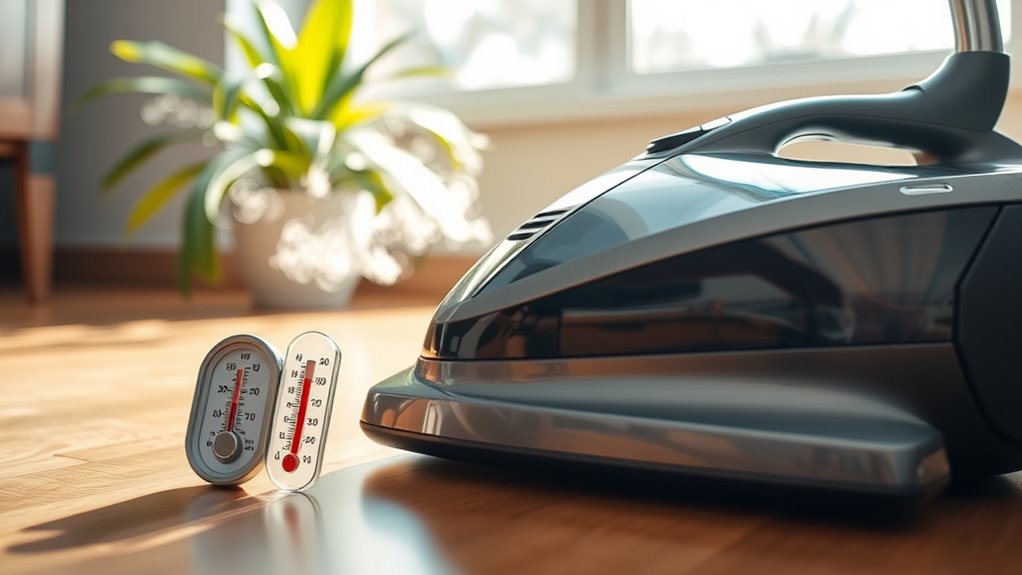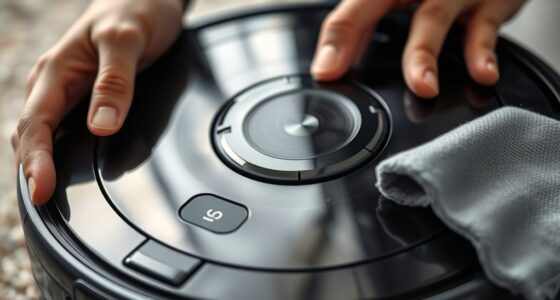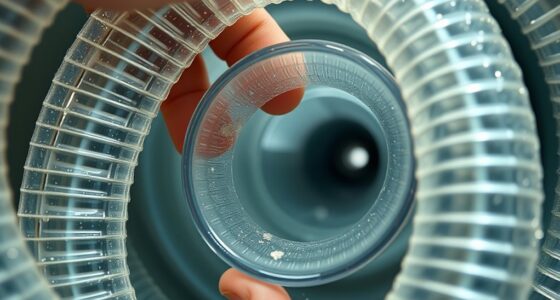To prevent vacuum overheating, you should regularly clean or replace filters and clear any clogs in hoses. Make sure your vacuum’s cooling system is functioning well, as it helps dissipate heat during use. Avoid overworking your vacuum on large areas or thick carpets for extended periods; take breaks to let it cool down. Using the right vacuum for specific tasks also minimizes strain. There are more tips and insights on maintaining your vacuum effectively.
Key Takeaways
- Regularly clean or replace filters to ensure proper airflow and prevent overheating.
- Check hoses and brush rolls for clogs to maintain optimal vacuum performance.
- Use the appropriate vacuum for the cleaning task to reduce motor workload.
- Take breaks during long cleaning sessions to allow the vacuum to cool down.
- Consult the manual for maintenance tips and seek professional help for cooling system issues.

Have you ever wondered why your vacuum overheats during a cleaning session? It can be frustrating when you’re in the middle of cleaning, and suddenly, your vacuum shuts down due to excessive heat. Understanding the causes behind this overheating and taking preventive measures can save you time and extend your vacuum’s life.
One significant factor is vacuum pump maintenance. If you neglect to maintain the vacuum pump, dust and debris can accumulate, restricting airflow and causing the motor to work harder than necessary. This added strain generates excessive heat, which can lead to overheating. To avoid this, make it a habit to regularly clean or replace the vacuum filter and check for clogs in the hose or brush roll. A well-maintained vacuum pump not only performs better but also minimizes the risk of overheating.
Regular vacuum pump maintenance is crucial to prevent overheating; clean filters and check for clogs to ensure optimal performance.
Another critical aspect is the cooling system integration within your vacuum. Many modern vacuums come equipped with cooling systems designed to manage heat effectively during operation. However, if the cooling system isn’t functioning properly, it won’t dissipate heat as efficiently, leading to overheating. You should pay attention to any unusual noises or reduced suction power, as these could indicate a problem with the cooling system. If you notice any irregularities, it’s best to consult your user manual or a professional for assistance.
Additionally, consider the environment in which you’re using your vacuum. If you’re cleaning a particularly large area or tackling thick carpets, your vacuum may need to work harder, generating more heat. Take breaks during long cleaning sessions to allow the motor to cool down. It’s a simple yet effective way to prevent overheating.
Lastly, confirm that you’re using the right vacuum for the job. Some vacuums are designed for specific surfaces or types of debris. If you’re using a vacuum not suited for your cleaning task, it may struggle, creating more heat and risking overheating. Always choose a vacuum that matches your cleaning needs for peak performance. Moreover, keeping in mind proper vacuum pump maintenance can greatly enhance the longevity of your device and prevent overheating issues.
Frequently Asked Questions
What Are the Signs of a Vacuum Overheating?
You’ll notice several signs of a vacuum overheating. The vacuum motor may emit a burning smell, indicating it’s working too hard. You might also hear unusual noises or see a drop in suction power. An overheating warning light could appear, signaling that the motor needs attention. If the vacuum feels excessively hot to the touch, it’s time to stop using it and check for any blockages or issues before continuing.
Can I Use My Vacuum While It’s Overheating?
No, you shouldn’t use your vacuum while it’s overheating. It can damage the vacuum motor and lead to more serious issues. Overheating causes, like blockages or worn-out components, need your attention first. Ignoring these problems might seem tempting if you’re in a hurry, but it can cost you more in the long run. Let the vacuum cool down, check for clogs, and guarantee it’s in good working condition before using it again.
How Often Should I Clean My Vacuum to Prevent Overheating?
You should clean your vacuum regularly to guarantee optimal performance and prevent overheating. A good cleaning schedule is to check and clean the filters and brush rolls every month, while emptying the dustbin after each use. Regular vacuum maintenance helps keep your machine running smoothly and efficiently. By sticking to this routine, you’ll not only extend your vacuum’s lifespan but also enjoy better suction and cleaner floors.
Does the Vacuum’s Brand Affect Overheating Risk?
Yes, the vacuum’s brand can affect overheating risk. Some brands prioritize quality and innovative designs, which can help minimize overheating issues. Have you ever considered how a reputable brand might guarantee better airflow and efficient motor function? Investing in a reliable vacuum brand often means enhanced performance and durability, leading to less risk of overheating. So, when choosing a vacuum, it’s wise to research brands known for their reliability and effectiveness.
Can Vacuum Overheating Damage Other Appliances?
Yes, vacuum overheating can damage other appliances. When your vacuum motor overheats, it can cause electrical surges that may affect nearby devices. If you’re using multiple appliances on the same circuit, the risk increases. The overheating damage can lead to malfunctions or even permanent failure of your appliances. To protect your equipment, make sure to monitor your vacuum’s performance and stop using it if it shows signs of overheating.
Conclusion
In summary, keeping your vacuum from overheating is all about regular maintenance and smart usage. Remember, “an ounce of prevention is worth a pound of cure.” By cleaning filters, emptying dust bins, and avoiding prolonged use, you’ll guarantee your vacuum runs smoothly and lasts longer. So, pay attention to those little details, and you won’t have to deal with the hassle of an overheated vacuum. Happy cleaning!









